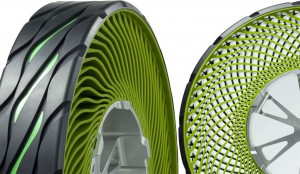They’re arguably the most important part of your car, yet the fundamental design of those four black donuts hasn’t changed all that much since Scottish veterinarian John Boyd came up with an inflatable rubber tire for his son’s bicycle back in 1887.
But that could be ready to change, at least if Bridgestone has its way with the Air Free tires it is demonstrating at the Paris Motor Show. As this name implies, the second-generation prototype no longer has to maintain a tight seal to stay inflated. Instead, it relies on just a thin band of solid rubber supported by flexible resin spokes.
The Bridgestone Air Free tires aren’t designed to provide temporary help, like today’s Run Flats, but to completely replace the conventional pneumatic tires used on cars, trucks, bicycles, and so many other products in use around the world.
There are several reasons why Bridgestone says it is working up the Air Free concept – but the project also faces a number of tough challenges.
(Live from Paris…Click Here for complete coverage of this year’s auto show.)
First shown in 2011, the Bridgestone design would eliminate the ever-present danger of flats and blow-outs. And unlike conventional tires which have long posed a major environmental challenge, the tiremaker claims that every piece of the Air Free tire is recyclable. And instead of tossing out the entire wheel when the tread wears out, Bridgestone says, the thin rubber band can be readily replaced.
The second-generation prototype, meanwhile, is said to offer a better ride and improved shock absorption.
That’s a major challenge. One of the key benefits Dr. Dunlop discovered was the way a tire filled with compressed air handled bumpy pavement compared to solid rubber wheels.
But while the basic concept may be the same as those first Scottish tires, today’s technology has advanced dramatically – modern radial tires last longer and provide better handling. The latest, low rolling resistance tires contribute significantly to the improved mileage on vehicles like the Toyota Prius and Chevrolet Volt.
Whether the new Bridgestone Air Free tires will be serve as a widespread replacement for conventional tires or simply find narrow niche applications remains to be seen. The Japanese company says it will begin a large fleet test of the technology in Tokyo next year on one-seat Toyota electric vehicles.
(Tesla set to make another big announcement. Click Here for a hint of what’s to come.)
Cost is another issue, though Bridgestone promises that the potential price would come down sharply as production increases. It certainly has the potential capacity, with conventional tire plants operating all over the world.
Tire manufacturers have spent decades – and countless millions of dollars – trying to find a replacement for the pneumatic design. The closest thing to a widespread alternative is the Run-Flat, actually just a modification of the standard tire. Under normal conditions, it also must be inflated. But if the tires goes flat, super-stiff sidewalls allow the car to keep driving for a short period, usually around 50 miles, to get help.
(Audi readying a plug-in hybrid assault in the coming years. Click Here to find out more.)
Automakers like Run-Flats because they eliminate the need for a spare tire. But consumers complain about the rough ride and cost.
Several of Bridgestone’s competitors are working on their own airless tire concepts, including Michelin’s Tweel, Britek’s Energy Return Wheel, and the Hankook i-Flex. Some have found limited application on construction and military vehicles, but the Holy Grail for the tire industry is to come up with an affordable, safe and environmentally friendly design that could be used on the more than 80 million passenger cars produced around the world each year.

